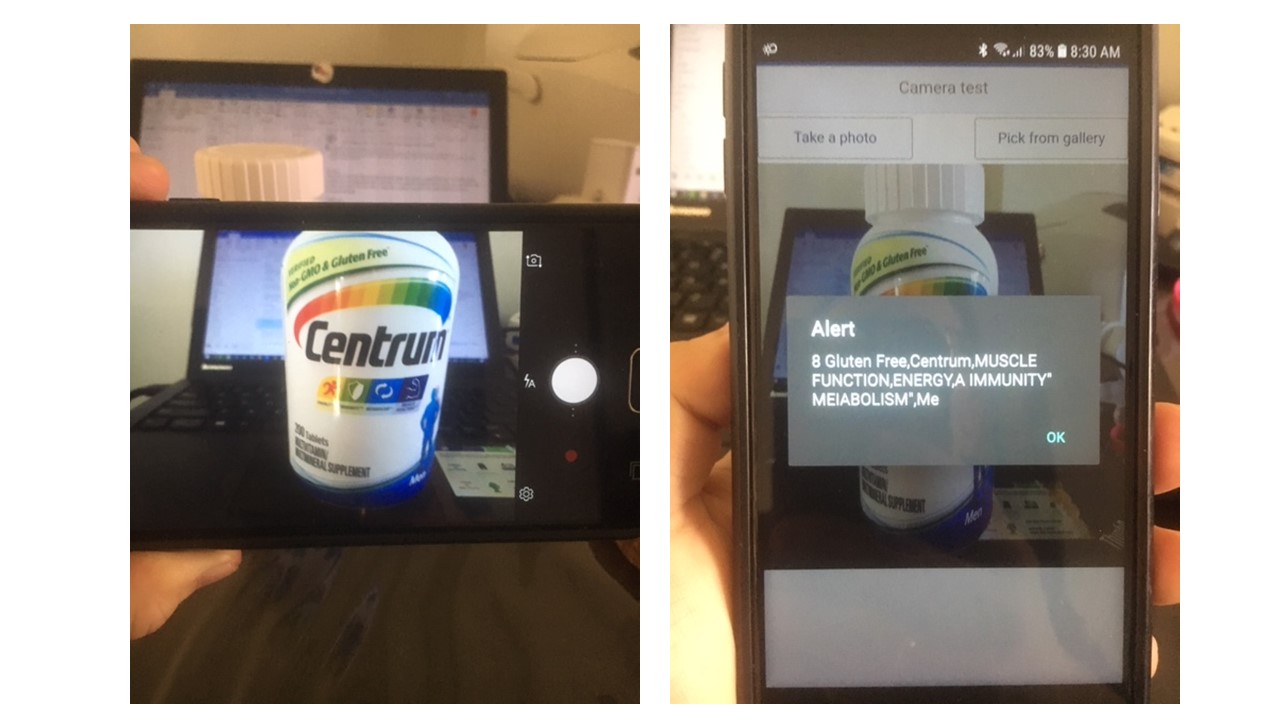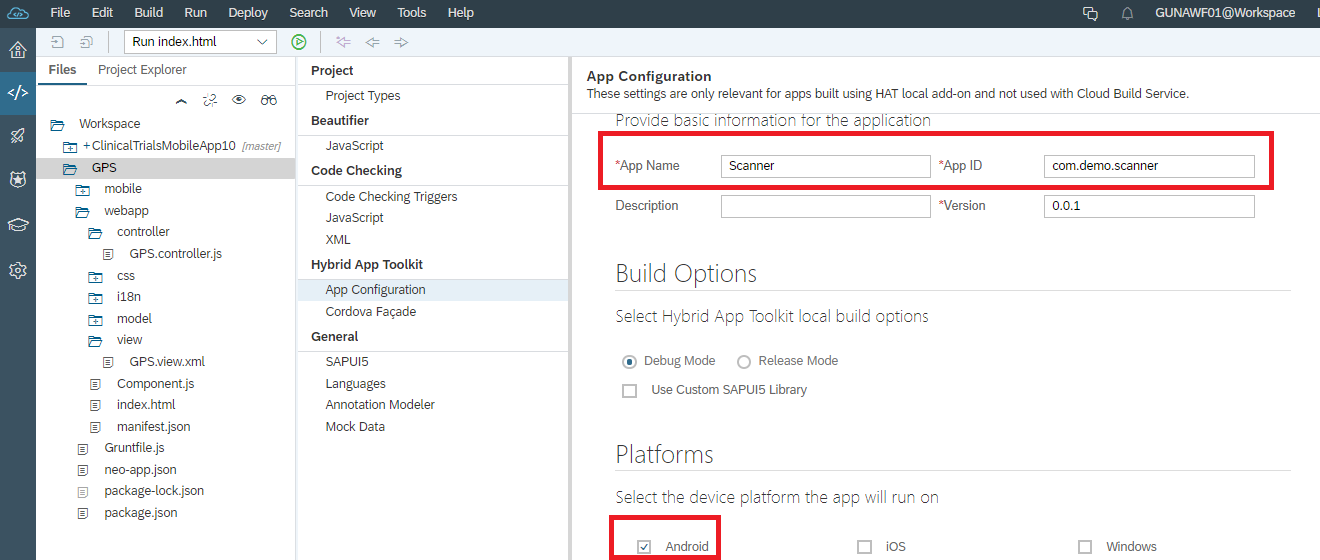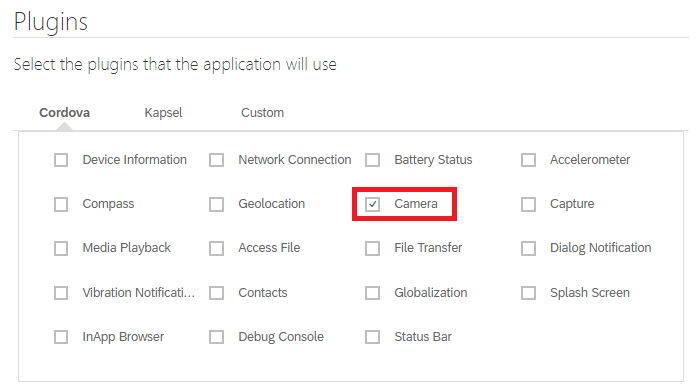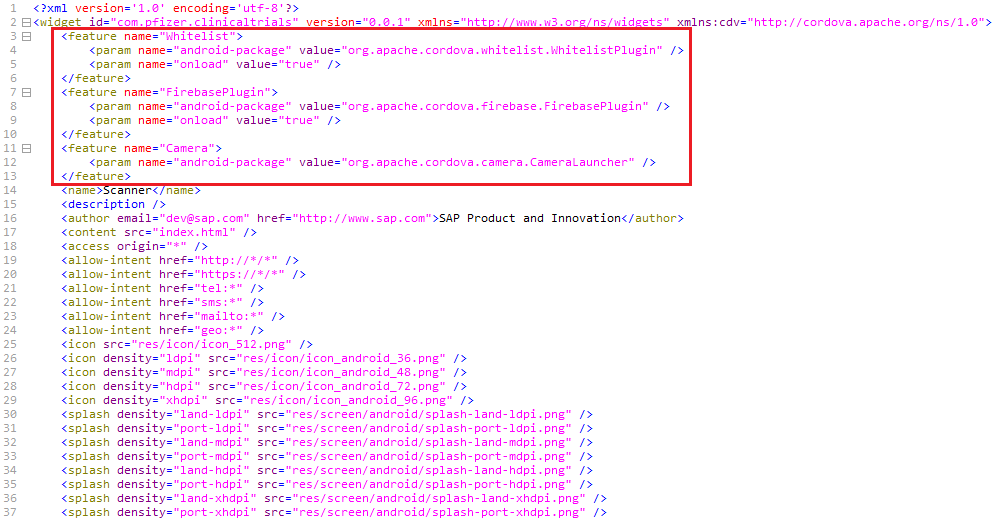
- SAP Community
- Products and Technology
- Technology
- Technology Blogs by Members
- Create Text Recognition (OCR) App with Google ML K...
Technology Blogs by Members
Explore a vibrant mix of technical expertise, industry insights, and tech buzz in member blogs covering SAP products, technology, and events. Get in the mix!
Turn on suggestions
Auto-suggest helps you quickly narrow down your search results by suggesting possible matches as you type.
Showing results for
ferrygun18
Contributor
Options
- Subscribe to RSS Feed
- Mark as New
- Mark as Read
- Bookmark
- Subscribe
- Printer Friendly Page
- Report Inappropriate Content
01-08-2019
11:30 AM
In this tutorial, I would like to go through on how to build the text scanner (OCR) app with Google ML and SAP Web IDE. The app that we are going to build is the Android Cordova SAPUI5 that has two functions: Take Photo and Pick from Gallery.
Take Photo
To snap a photo and feed into the text recognizer and get the OCR result.
Pick from Gallery
To feed the text recognizer with the available existing images from the phone gallery and get the OCR result.
Once it get recognized, the dialog box with the OCR result will pop-up. We can then use this information to proceed further like getting the information from the SAP back-end through oData, etc.
The final app will look like this:

Let's go through the following steps.
Configure Local HAT installation by following this blog: Check my previous blog on how to install SAP HAT on your machine: https://blogs.sap.com/2019/01/07/build-android-sapui5-ocr-scanner-with-sap-web-ide-and-anyline-ocr-s....
Download all plugins to local custom plugin folder.

Since the Cordova ML Text plugin requires cordova 7.1.0+ , cordova android 6.4.0+, we need to modify the local SAP HAT installation to meet this requirement.
On the SAP HAT Local folder, go to ./setup/server/routes/check.js and modify line 302 to use cordova android 6.4.0:


Now run HAT setup from command line and make sure status is passed.


Once the setup is completed, run the HAT server from command line.

Open SAP Web IDE Full Stack and go to Preferences > Hybrid Application Toolkit. Click Test Connection and make sure the connection is available.

Create a new project from template.

Go to Project Settings > Hybrid App Toolkit > App Configuration
Provide the app name Scanner and app id com.demo.scanner and select Android since we are going to build the android app.

Under Cordova plugin, select camera.

Under Custom plugin, select Google Firebase and Mltext and click Save.

Deploy the app. Right click on the app that we created and select Deploy > Prepare Hybrid Project.

Preparation in progress. It is also installing the custom plugins.

Once it is done, go to C:\Users\<user>\SAPHybrid folder. The project Scanner is created there.

The created cordova project is still using version 6.2.3 and it will not meet the Cordova ML Text plugin (6.4.0). Let's update it to 6.4.0.
Go to C:\Users\<user>\SAPHybrid\Scanner\hybrid\platforms\android and run this command:

I checked C:\Users\<user>\SAPHybrid\Scanner\hybrid\platforms\android\res\xml\config.xml and it looks like the Cordova ML Text plugin was not added successfully.

Let's add it manually then, run this command:
Now we got the plugin installed:

We also need to remove the cordova-plugin-compat otherwise we will have an error during build process. Refer to this https://stackoverflow.com/questions/46562289/multiple-dex-files-define-lorg-apache-cordova-buildhelp...

And this would be the final plugin list:

Go to Firebase console https://console.firebase.google.com and create a new project.

Go to Project settings and click Add Firebase to your Android App.

Add android package name com.demo.scanner and click Register app.

Download google-services.json.

And place it under C:\Users\<user>\SAPHybrid\Scanner\hybrid\platforms\android

Open Android Studio and import the project C:\Users\<user>\SAPHybrid\Scanner\hybrid\platforms\android

Update the build.gradle: Android and CordovaLib project

Update build.gradle: Android:



Update build.gradle: CordovaLib:

And now you can build the app without error.
Take a look at the function below from the controller from the asset folder.
mltext.getText was called to recognize the text in the image and will get the result from recognizedText.

Complete code is here.
And finally that's all that I would like to cover.
Take Photo
To snap a photo and feed into the text recognizer and get the OCR result.
Pick from Gallery
To feed the text recognizer with the available existing images from the phone gallery and get the OCR result.
Once it get recognized, the dialog box with the OCR result will pop-up. We can then use this information to proceed further like getting the information from the SAP back-end through oData, etc.
The final app will look like this:

Let's go through the following steps.
Configure Local HAT
Configure Local HAT installation by following this blog: Check my previous blog on how to install SAP HAT on your machine: https://blogs.sap.com/2019/01/07/build-android-sapui5-ocr-scanner-with-sap-web-ide-and-anyline-ocr-s....
Download Plugins
Download all plugins to local custom plugin folder.
- Cordova ML Text Plugin
https://bitbucket.org/bhivedevs/cordova-plugin-ml-text.git. - Cordova Plugin Firebase
https://www.npmjs.com/package/cordova-plugin-firebase - Cordova Plugin Camera
We will configure in Web IDE

Update Local HAT Installation
Since the Cordova ML Text plugin requires cordova 7.1.0+ , cordova android 6.4.0+, we need to modify the local SAP HAT installation to meet this requirement.
On the SAP HAT Local folder, go to ./setup/server/routes/check.js and modify line 302 to use cordova android 6.4.0:


cmd: 'cordova platform add ' + platform + (platform==="android"?"@6.4.0":""), // for android sdk tools > 26.0.1Run HAT
Now run HAT setup from command line and make sure status is passed.


Once the setup is completed, run the HAT server from command line.

Configure SAP Web IDE
Open SAP Web IDE Full Stack and go to Preferences > Hybrid Application Toolkit. Click Test Connection and make sure the connection is available.

Create a new project from template.

Go to Project Settings > Hybrid App Toolkit > App Configuration
Provide the app name Scanner and app id com.demo.scanner and select Android since we are going to build the android app.

Under Cordova plugin, select camera.

Under Custom plugin, select Google Firebase and Mltext and click Save.

Deploy the app. Right click on the app that we created and select Deploy > Prepare Hybrid Project.

Preparation in progress. It is also installing the custom plugins.

Modify the Plugins
Once it is done, go to C:\Users\<user>\SAPHybrid folder. The project Scanner is created there.

The created cordova project is still using version 6.2.3 and it will not meet the Cordova ML Text plugin (6.4.0). Let's update it to 6.4.0.
Go to C:\Users\<user>\SAPHybrid\Scanner\hybrid\platforms\android and run this command:

I checked C:\Users\<user>\SAPHybrid\Scanner\hybrid\platforms\android\res\xml\config.xml and it looks like the Cordova ML Text plugin was not added successfully.

Let's add it manually then, run this command:
cordova plugin add https://bitbucket.org/bhivedevs/cordova-plugin-ml-text.gitNow we got the plugin installed:

We also need to remove the cordova-plugin-compat otherwise we will have an error during build process. Refer to this https://stackoverflow.com/questions/46562289/multiple-dex-files-define-lorg-apache-cordova-buildhelp...

And this would be the final plugin list:

Create the Firebase Config File
Go to Firebase console https://console.firebase.google.com and create a new project.

Go to Project settings and click Add Firebase to your Android App.

Add android package name com.demo.scanner and click Register app.

Download google-services.json.

And place it under C:\Users\<user>\SAPHybrid\Scanner\hybrid\platforms\android

Import to Android Studio
Open Android Studio and import the project C:\Users\<user>\SAPHybrid\Scanner\hybrid\platforms\android

Update the build.gradle: Android and CordovaLib project

Update build.gradle: Android:



Update build.gradle: CordovaLib:

And now you can build the app without error.
Main Program
Take a look at the function below from the controller from the asset folder.
mltext.getText was called to recognize the text in the image and will get the result from recognizedText.

return Controller.extend("GPS.GPS.controller.GPS", {
oView: null,
onInit: function() {
oView = this.getView();
},
onPhotoDataSuccess: function(imageData) {
var myImage = oView.byId("myImage");
myImage.setSrc("data:image/jpeg;base64," + imageData);
mltext.getText(onSuccess, onFail, {
imgType: 4,
imgSrc: imageData
});
// for imgType Use 0,1,2,3 or 4
function onSuccess(recognizedText) {
//var element = document.getElementById('pp');
//element.innerHTML=recognizedText.blocks.blocktext;
//Use above two lines to show recognizedText in html
console.log(recognizedText);
alert(recognizedText.blocks.blocktext);
}
function onFail(message) {
alert('Failed because: ' + message);
}
},
onPhotoURISuccess: function(imageURI) {
var myImage = oView.byId("myImage");
myImage.setSrc(imageURI);
mltext.getText(onSuccess, onFail, {
imgType: 0,
imgSrc: imageURI
});
// for imgType Use 0,1,2,3 or 4
function onSuccess(recognizedText) {
//var element = document.getElementById('pp');
//element.innerHTML=recognizedText.blocks.blocktext;
//Use above two lines to show recognizedText in html
console.log(recognizedText);
alert(recognizedText.blocks.blocktext);
}
function onFail(message) {
alert('Failed because: ' + message);
}
},
onFail: function(message) {
console.log("Failed because: " + message);
},
getPhoto: function() {
var oNav = navigator.camera;
oNav.getPicture(this.onPhotoURISuccess, this.onFail, {
quality: 100,
destinationType: oNav.DestinationType.FILE_URI,
sourceType: oNav.PictureSourceType.PHOTOLIBRARY
});
},
capturePhoto: function() {
var oNav = navigator.camera;
oNav.getPicture(this.onPhotoDataSuccess, this.onFail, {
quality: 100,
destinationType: oNav.DestinationType.DATA_URL
});
}
});Complete code is here.
And finally that's all that I would like to cover.
- SAP Managed Tags:
- SAP Business Application Studio,
- SAPUI5
2 Comments
You must be a registered user to add a comment. If you've already registered, sign in. Otherwise, register and sign in.
Labels in this area
-
"automatische backups"
1 -
"regelmäßige sicherung"
1 -
"TypeScript" "Development" "FeedBack"
1 -
505 Technology Updates 53
1 -
ABAP
14 -
ABAP API
1 -
ABAP CDS Views
2 -
ABAP CDS Views - BW Extraction
1 -
ABAP CDS Views - CDC (Change Data Capture)
1 -
ABAP class
2 -
ABAP Cloud
2 -
ABAP Development
5 -
ABAP in Eclipse
1 -
ABAP Platform Trial
1 -
ABAP Programming
2 -
abap technical
1 -
absl
1 -
access data from SAP Datasphere directly from Snowflake
1 -
Access data from SAP datasphere to Qliksense
1 -
Accrual
1 -
action
1 -
adapter modules
1 -
Addon
1 -
Adobe Document Services
1 -
ADS
1 -
ADS Config
1 -
ADS with ABAP
1 -
ADS with Java
1 -
ADT
2 -
Advance Shipping and Receiving
1 -
Advanced Event Mesh
3 -
AEM
1 -
AI
7 -
AI Launchpad
1 -
AI Projects
1 -
AIML
9 -
Alert in Sap analytical cloud
1 -
Amazon S3
1 -
Analytical Dataset
1 -
Analytical Model
1 -
Analytics
1 -
Analyze Workload Data
1 -
annotations
1 -
API
1 -
API and Integration
3 -
API Call
2 -
Application Architecture
1 -
Application Development
5 -
Application Development for SAP HANA Cloud
3 -
Applications and Business Processes (AP)
1 -
Artificial Intelligence
1 -
Artificial Intelligence (AI)
4 -
Artificial Intelligence (AI) 1 Business Trends 363 Business Trends 8 Digital Transformation with Cloud ERP (DT) 1 Event Information 462 Event Information 15 Expert Insights 114 Expert Insights 76 Life at SAP 418 Life at SAP 1 Product Updates 4
1 -
Artificial Intelligence (AI) blockchain Data & Analytics
1 -
Artificial Intelligence (AI) blockchain Data & Analytics Intelligent Enterprise
1 -
Artificial Intelligence (AI) blockchain Data & Analytics Intelligent Enterprise Oil Gas IoT Exploration Production
1 -
Artificial Intelligence (AI) blockchain Data & Analytics Intelligent Enterprise sustainability responsibility esg social compliance cybersecurity risk
1 -
ASE
1 -
ASR
2 -
ASUG
1 -
Attachments
1 -
Authorisations
1 -
Automating Processes
1 -
Automation
1 -
aws
2 -
Azure
1 -
Azure AI Studio
1 -
B2B Integration
1 -
Backorder Processing
1 -
Backup
1 -
Backup and Recovery
1 -
Backup schedule
1 -
BADI_MATERIAL_CHECK error message
1 -
Bank
1 -
BAS
1 -
basis
2 -
Basis Monitoring & Tcodes with Key notes
2 -
Batch Management
1 -
BDC
1 -
Best Practice
1 -
bitcoin
1 -
Blockchain
3 -
BOP in aATP
1 -
BOP Segments
1 -
BOP Strategies
1 -
BOP Variant
1 -
BPC
1 -
BPC LIVE
1 -
BTP
11 -
BTP Destination
2 -
Business AI
1 -
Business and IT Integration
1 -
Business application stu
1 -
Business Application Studio
1 -
Business Architecture
1 -
Business Communication Services
1 -
Business Continuity
1 -
Business Data Fabric
3 -
Business Partner
12 -
Business Partner Master Data
10 -
Business Technology Platform
2 -
Business Trends
1 -
CA
1 -
calculation view
1 -
CAP
3 -
Capgemini
1 -
CAPM
1 -
Catalyst for Efficiency: Revolutionizing SAP Integration Suite with Artificial Intelligence (AI) and
1 -
CCMS
2 -
CDQ
12 -
CDS
2 -
Cental Finance
1 -
Certificates
1 -
CFL
1 -
Change Management
1 -
chatbot
1 -
chatgpt
3 -
CL_SALV_TABLE
2 -
Class Runner
1 -
Classrunner
1 -
Cloud ALM Monitoring
1 -
Cloud ALM Operations
1 -
cloud connector
1 -
Cloud Extensibility
1 -
Cloud Foundry
4 -
Cloud Integration
6 -
Cloud Platform Integration
2 -
cloudalm
1 -
communication
1 -
Compensation Information Management
1 -
Compensation Management
1 -
Compliance
1 -
Compound Employee API
1 -
Configuration
1 -
Connectors
1 -
Consolidation Extension for SAP Analytics Cloud
1 -
Controller-Service-Repository pattern
1 -
Conversion
1 -
Cosine similarity
1 -
cryptocurrency
1 -
CSI
1 -
ctms
1 -
Custom chatbot
3 -
Custom Destination Service
1 -
custom fields
1 -
Customer Experience
1 -
Customer Journey
1 -
Customizing
1 -
cyber security
2 -
Data
1 -
Data & Analytics
1 -
Data Aging
1 -
Data Analytics
2 -
Data and Analytics (DA)
1 -
Data Archiving
1 -
Data Back-up
1 -
Data Governance
5 -
Data Integration
2 -
Data Quality
12 -
Data Quality Management
12 -
Data Synchronization
1 -
data transfer
1 -
Data Unleashed
1 -
Data Value
8 -
database tables
1 -
Datasphere
2 -
datenbanksicherung
1 -
dba cockpit
1 -
dbacockpit
1 -
Debugging
2 -
Delimiting Pay Components
1 -
Delta Integrations
1 -
Destination
3 -
Destination Service
1 -
Developer extensibility
1 -
Developing with SAP Integration Suite
1 -
Devops
1 -
digital transformation
1 -
Documentation
1 -
Dot Product
1 -
DQM
1 -
dump database
1 -
dump transaction
1 -
e-Invoice
1 -
E4H Conversion
1 -
Eclipse ADT ABAP Development Tools
2 -
edoc
1 -
edocument
1 -
ELA
1 -
Embedded Consolidation
1 -
Embedding
1 -
Embeddings
1 -
Employee Central
1 -
Employee Central Payroll
1 -
Employee Central Time Off
1 -
Employee Information
1 -
Employee Rehires
1 -
Enable Now
1 -
Enable now manager
1 -
endpoint
1 -
Enhancement Request
1 -
Enterprise Architecture
1 -
ETL Business Analytics with SAP Signavio
1 -
Euclidean distance
1 -
Event Dates
1 -
Event Driven Architecture
1 -
Event Mesh
2 -
Event Reason
1 -
EventBasedIntegration
1 -
EWM
1 -
EWM Outbound configuration
1 -
EWM-TM-Integration
1 -
Existing Event Changes
1 -
Expand
1 -
Expert
2 -
Expert Insights
1 -
Fiori
14 -
Fiori Elements
2 -
Fiori SAPUI5
12 -
Flask
1 -
Full Stack
8 -
Funds Management
1 -
General
1 -
Generative AI
1 -
Getting Started
1 -
GitHub
8 -
Grants Management
1 -
groovy
1 -
GTP
1 -
HANA
5 -
HANA Cloud
2 -
Hana Cloud Database Integration
2 -
HANA DB
1 -
HANA XS Advanced
1 -
Historical Events
1 -
home labs
1 -
HowTo
1 -
HR Data Management
1 -
html5
8 -
HTML5 Application
1 -
Identity cards validation
1 -
idm
1 -
Implementation
1 -
input parameter
1 -
instant payments
1 -
Integration
3 -
Integration Advisor
1 -
Integration Architecture
1 -
Integration Center
1 -
Integration Suite
1 -
intelligent enterprise
1 -
Java
1 -
job
1 -
Job Information Changes
1 -
Job-Related Events
1 -
Job_Event_Information
1 -
joule
4 -
Journal Entries
1 -
Just Ask
1 -
Kerberos for ABAP
8 -
Kerberos for JAVA
8 -
Launch Wizard
1 -
Learning Content
2 -
Life at SAP
1 -
lightning
1 -
Linear Regression SAP HANA Cloud
1 -
local tax regulations
1 -
LP
1 -
Machine Learning
2 -
Marketing
1 -
Master Data
3 -
Master Data Management
14 -
Maxdb
2 -
MDG
1 -
MDGM
1 -
MDM
1 -
Message box.
1 -
Messages on RF Device
1 -
Microservices Architecture
1 -
Microsoft Universal Print
1 -
Middleware Solutions
1 -
Migration
5 -
ML Model Development
1 -
Modeling in SAP HANA Cloud
8 -
Monitoring
3 -
MTA
1 -
Multi-Record Scenarios
1 -
Multiple Event Triggers
1 -
Neo
1 -
New Event Creation
1 -
New Feature
1 -
Newcomer
1 -
NodeJS
2 -
ODATA
2 -
OData APIs
1 -
odatav2
1 -
ODATAV4
1 -
ODBC
1 -
ODBC Connection
1 -
Onpremise
1 -
open source
2 -
OpenAI API
1 -
Oracle
1 -
PaPM
1 -
PaPM Dynamic Data Copy through Writer function
1 -
PaPM Remote Call
1 -
PAS-C01
1 -
Pay Component Management
1 -
PGP
1 -
Pickle
1 -
PLANNING ARCHITECTURE
1 -
Popup in Sap analytical cloud
1 -
PostgrSQL
1 -
POSTMAN
1 -
Process Automation
2 -
Product Updates
4 -
PSM
1 -
Public Cloud
1 -
Python
4 -
Qlik
1 -
Qualtrics
1 -
RAP
3 -
RAP BO
2 -
Record Deletion
1 -
Recovery
1 -
recurring payments
1 -
redeply
1 -
Release
1 -
Remote Consumption Model
1 -
Replication Flows
1 -
Research
1 -
Resilience
1 -
REST
1 -
REST API
1 -
Retagging Required
1 -
Risk
1 -
Rolling Kernel Switch
1 -
route
1 -
rules
1 -
S4 HANA
1 -
S4 HANA Cloud
1 -
S4 HANA On-Premise
1 -
S4HANA
3 -
S4HANA_OP_2023
2 -
SAC
10 -
SAC PLANNING
9 -
SAP
4 -
SAP ABAP
1 -
SAP Advanced Event Mesh
1 -
SAP AI Core
8 -
SAP AI Launchpad
8 -
SAP Analytic Cloud Compass
1 -
Sap Analytical Cloud
1 -
SAP Analytics Cloud
4 -
SAP Analytics Cloud for Consolidation
2 -
SAP Analytics Cloud Story
1 -
SAP analytics clouds
1 -
SAP BAS
1 -
SAP Basis
6 -
SAP BODS
1 -
SAP BODS certification.
1 -
SAP BTP
20 -
SAP BTP Build Work Zone
2 -
SAP BTP Cloud Foundry
5 -
SAP BTP Costing
1 -
SAP BTP CTMS
1 -
SAP BTP Innovation
1 -
SAP BTP Migration Tool
1 -
SAP BTP SDK IOS
1 -
SAP Build
11 -
SAP Build App
1 -
SAP Build apps
1 -
SAP Build CodeJam
1 -
SAP Build Process Automation
3 -
SAP Build work zone
10 -
SAP Business Objects Platform
1 -
SAP Business Technology
2 -
SAP Business Technology Platform (XP)
1 -
sap bw
1 -
SAP CAP
2 -
SAP CDC
1 -
SAP CDP
1 -
SAP CDS VIEW
1 -
SAP Certification
1 -
SAP Cloud ALM
4 -
SAP Cloud Application Programming Model
1 -
SAP Cloud Integration for Data Services
1 -
SAP cloud platform
8 -
SAP Companion
1 -
SAP CPI
3 -
SAP CPI (Cloud Platform Integration)
2 -
SAP CPI Discover tab
1 -
sap credential store
1 -
SAP Customer Data Cloud
1 -
SAP Customer Data Platform
1 -
SAP Data Intelligence
1 -
SAP Data Migration in Retail Industry
1 -
SAP Data Services
1 -
SAP DATABASE
1 -
SAP Dataspher to Non SAP BI tools
1 -
SAP Datasphere
9 -
SAP DRC
1 -
SAP EWM
1 -
SAP Fiori
2 -
SAP Fiori App Embedding
1 -
Sap Fiori Extension Project Using BAS
1 -
SAP GRC
1 -
SAP HANA
1 -
SAP HCM (Human Capital Management)
1 -
SAP HR Solutions
1 -
SAP IDM
1 -
SAP Integration Suite
9 -
SAP Integrations
4 -
SAP iRPA
2 -
SAP Learning Class
1 -
SAP Learning Hub
1 -
SAP Odata
2 -
SAP on Azure
1 -
SAP PartnerEdge
1 -
sap partners
1 -
SAP Password Reset
1 -
SAP PO Migration
1 -
SAP Prepackaged Content
1 -
SAP Process Automation
2 -
SAP Process Integration
2 -
SAP Process Orchestration
1 -
SAP S4HANA
2 -
SAP S4HANA Cloud
1 -
SAP S4HANA Cloud for Finance
1 -
SAP S4HANA Cloud private edition
1 -
SAP Sandbox
1 -
SAP STMS
1 -
SAP SuccessFactors
2 -
SAP SuccessFactors HXM Core
1 -
SAP Time
1 -
SAP TM
2 -
SAP Trading Partner Management
1 -
SAP UI5
1 -
SAP Upgrade
1 -
SAP Utilities
1 -
SAP-GUI
8 -
SAP_COM_0276
1 -
SAPBTP
1 -
SAPCPI
1 -
SAPEWM
1 -
sapmentors
1 -
saponaws
2 -
SAPS4HANA
1 -
SAPUI5
4 -
schedule
1 -
Secure Login Client Setup
8 -
security
9 -
Selenium Testing
1 -
SEN
1 -
SEN Manager
1 -
service
1 -
SET_CELL_TYPE
1 -
SET_CELL_TYPE_COLUMN
1 -
SFTP scenario
2 -
Simplex
1 -
Single Sign On
8 -
Singlesource
1 -
SKLearn
1 -
soap
1 -
Software Development
1 -
SOLMAN
1 -
solman 7.2
2 -
Solution Manager
3 -
sp_dumpdb
1 -
sp_dumptrans
1 -
SQL
1 -
sql script
1 -
SSL
8 -
SSO
8 -
Substring function
1 -
SuccessFactors
1 -
SuccessFactors Time Tracking
1 -
Sybase
1 -
system copy method
1 -
System owner
1 -
Table splitting
1 -
Tax Integration
1 -
Technical article
1 -
Technical articles
1 -
Technology Updates
1 -
Technology Updates
1 -
Technology_Updates
1 -
Threats
1 -
Time Collectors
1 -
Time Off
2 -
Tips and tricks
2 -
Tools
1 -
Trainings & Certifications
1 -
Transport in SAP BODS
1 -
Transport Management
1 -
TypeScript
2 -
unbind
1 -
Unified Customer Profile
1 -
UPB
1 -
Use of Parameters for Data Copy in PaPM
1 -
User Unlock
1 -
VA02
1 -
Validations
1 -
Vector Database
1 -
Vector Engine
1 -
Visual Studio Code
1 -
VSCode
1 -
Web SDK
1 -
work zone
1 -
workload
1 -
xsa
1 -
XSA Refresh
1
- « Previous
- Next »
Related Content
- Creating a JDBC Connection for Google BigQuery using SSO with Oauth 2.0 in Technology Q&A
- SAP HANA Cloud Vector Engine: Quick FAQ Reference in Technology Blogs by SAP
- Harnessing the Power of SAP HANA Cloud Vector Engine for Context-Aware LLM Architecture in Technology Blogs by SAP
- UNVEILING THE INNOVATIONS OF ARTIFICIAL INTELLIGENCE in Technology Q&A
- Configuration: SAP Ariba SSO with SAP Cloud Identity Services - Identity Authentication in Technology Blogs by SAP
Top kudoed authors
| User | Count |
|---|---|
| 11 | |
| 10 | |
| 7 | |
| 6 | |
| 4 | |
| 4 | |
| 3 | |
| 3 | |
| 3 | |
| 3 |